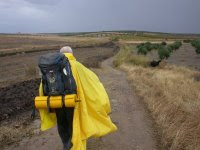Camino de Santiago, (the Way of St James)
 There are three great pilgrimages in Europe ending in Jerusalem, Rome and the cathedral in Santiago de Compostela in north-western Spain. Since the tenth century, pilgrims have made their way to Santiago via a network of trails known as the Camino de Santiago to revere the bones of the apostle St James, which are entombed in a silver casket in the cathedral.
There are three great pilgrimages in Europe ending in Jerusalem, Rome and the cathedral in Santiago de Compostela in north-western Spain. Since the tenth century, pilgrims have made their way to Santiago via a network of trails known as the Camino de Santiago to revere the bones of the apostle St James, which are entombed in a silver casket in the cathedral. The number of pilgrims peaked in the 11th and 12th centuries when an astonishing half a million people per year are thought to have made the pilgrimage. There was a steady decline in the ensuing centuries and, by the middle of the 20th century, only a few hardy souls made the trip. Since then there has been a renaissance and currently more than 70,000 Compostela, the certificate recognizing the completion of the Camino, are issued annually by the authorities in Santiago. In holy years, a year when St. James day (July 25) falls on a Sunday, this number more than doubles. The last holy year was in 2004 when more than 180,000 pilgrims reached Santiago.
There are a number of standard routes on the Camino. Some pilgrims walk the Via de la Plata from Seville in southern Spain (~1000 km), some walk the Camino Portugueses from Porto (~550 km) but the vast majority of pilgrims join the Camino France at some point between France and Santiago.
 Photo 676: From a cairn at O Cebreiro.
Photo 676: From a cairn at O Cebreiro.This is the story of my Camino.
It started in St Jean-Pied-de-Port, on the French side of the Pyrenees Mountains, on August 25, 2007 and ended 26 days and 776 km later in Santiago. Like many pilgrims, I then continued on for a further three days and 90 km to Finisterre, The End of the World, on the Atlantic coast.
“The Camino is really easy apart from walking and carrying your backpack”



Comments